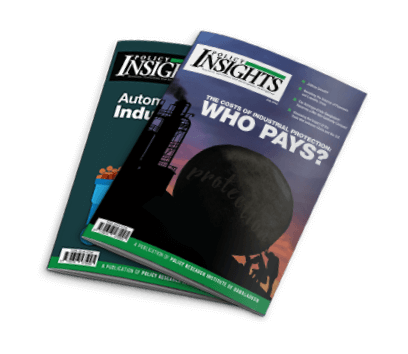Issue 19
November 2023
This issue of Policy Insights contains a set of analytical pieces dealing with the challenges that Bangladesh currently confronts in the evolving landscape of its economic trajectory. Over the past two decades, Bangladesh has undergone a remarkable transformation—from one of the poorest countries in the world to nearing graduation from the United Nation’s list of Least Developed Countries. This commendable progress now meets with unprecedented challenges combining rising inflation, depleting foreign exchange reserves, escalating debt servicing costs, and constrained fiscal space.
A critical issue in the discussion is the so-called middle-income country trap, as the current crisis could trigger a growth slowdown, leaving a long-lasting impact. There are many examples of developing economies trapped into middle-income country status. The cover article delves into this issue, elucidating empirical observations on how middle-income countries often experience a slowdown in productivity growth as they approach higher levels of per capita income. It underscores the gravity of addressing this trap, providing insights into potential opportunities for sustained long-term growth.
Turning our attention to export-oriented development, an article highlights the proven benefits which export-oriented development strategy brought for Bangladesh. However, it raises a critical concern about a longstanding challenge faced by the country—the heavy concentration of the country’s export basket on a single commodity group—readymade garments. It is in this backdrop that the importance of tariff reforms to counter excessive protection to import-competing sector at the cost of export competitiveness cannot be overemphasised.
Exploring the key drivers of development, another article recognises the pivotal role played by the garment, remittance, agriculture and non-government organisations in Bangladesh’s economic success. While acknowledging the garment exports’ contribution in the country’s development, it also points out that although the rest of the sectors face a hefty tariff structure, the garment sector is operating in a ‘free- trade’ enclave with zero-tariff. This dualism in trade policy is creating anti-export bias. Therefore, the article emphasises the necessity of greater efforts to enhance export competitiveness and diversification. The article also recommends tapping into remittance flows for future growth and development and seeking support from the G20 leaders for climate funds and long-term financing goals.
Another article in this issue of Policy Insights sheds light on the National Tariff Policy 2023, highlighting its salient features gearing towards sustaining export expansion and diversification, with a specific emphasis on promoting non-garment exports. Meanwhile, an insightful critique dissects the practice of setting unrealistic tax revenue targets in national budgets, cautioning against harmful consequences of wishful and non-transparent revenue goals.
The constraints and opportunities facing Bangladesh’s shipbuilding industry is the subject matter of the last article in this issue. Though there is a surge in local demand for ships driven by international trade expansion, the sector grapples with financing constraints, capacity issues, and challenges of environmental compliance. The article underscores the potential for growth through facilitative financing mechanisms and supportive government policies, positioning the shipbuilding sector to contribute significantly to global maritime trade and sustainable development.


